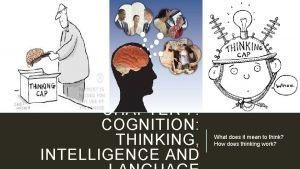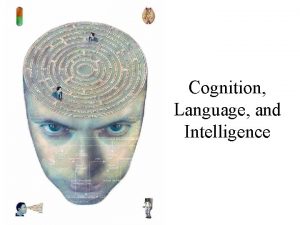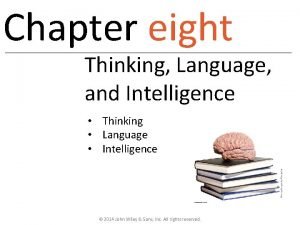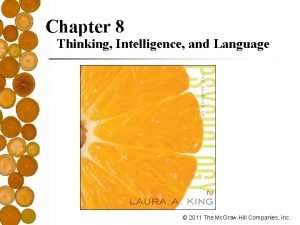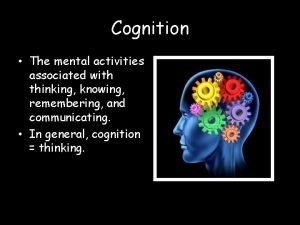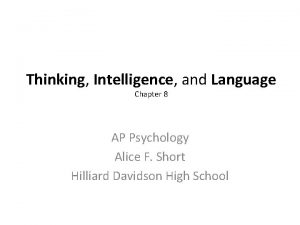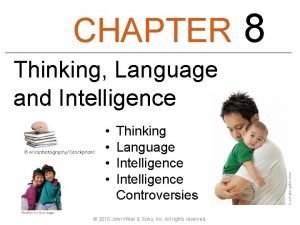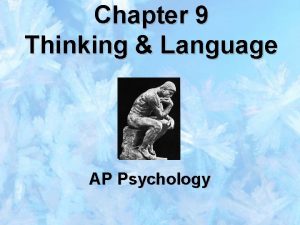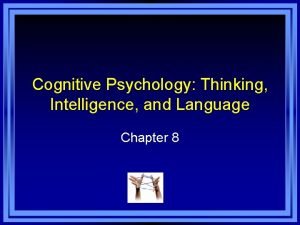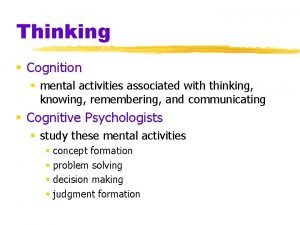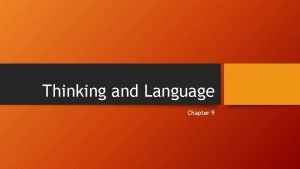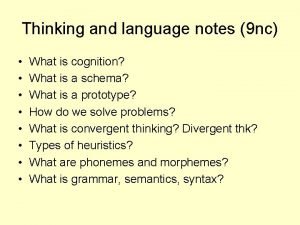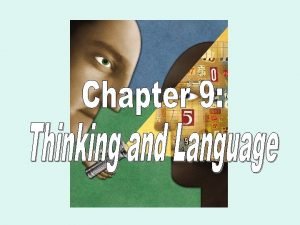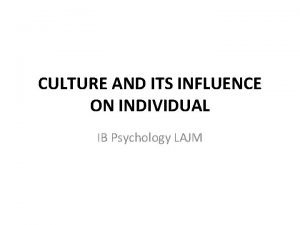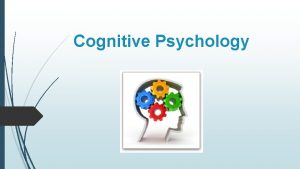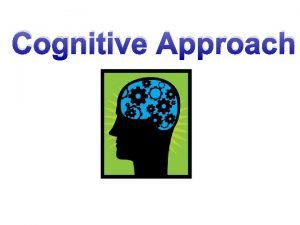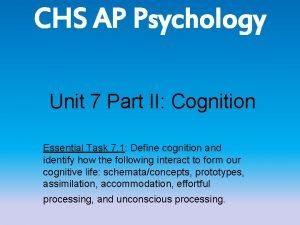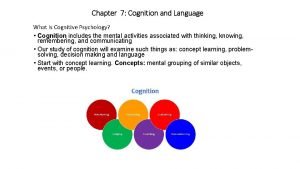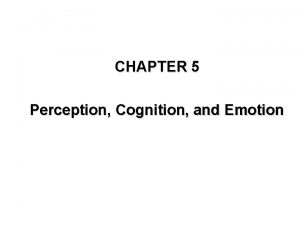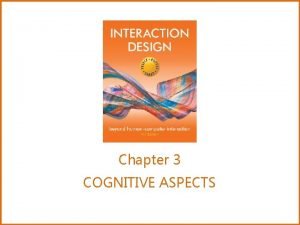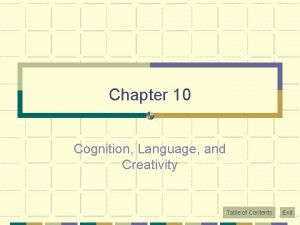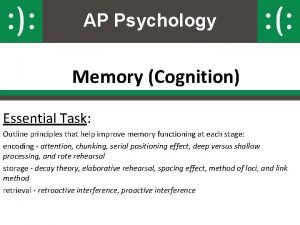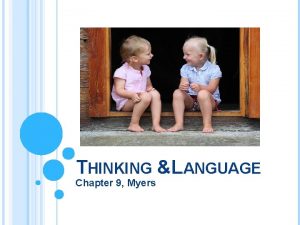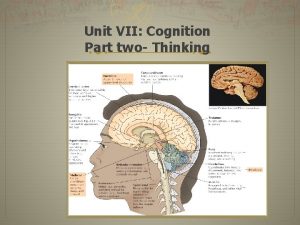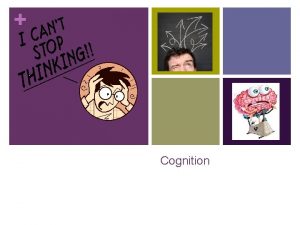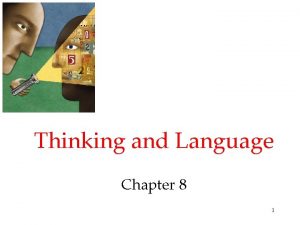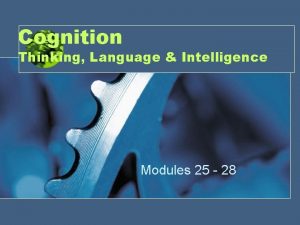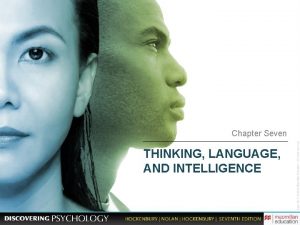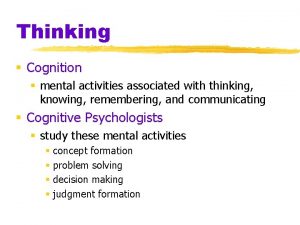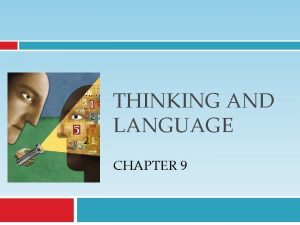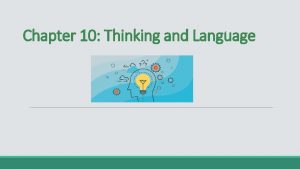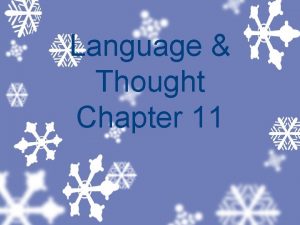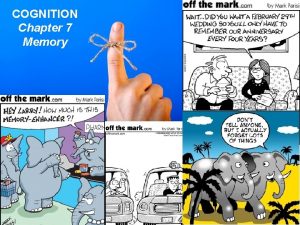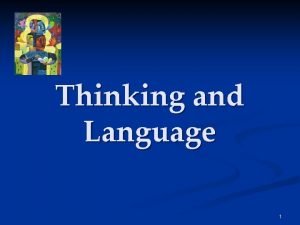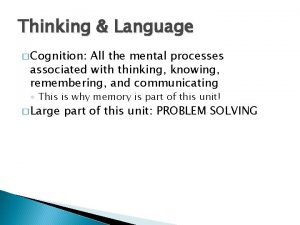Chapter 8 Thinking Language Intelligence Cognition the mental

































- Slides: 33

Chapter 8: Thinking, Language & Intelligence Cognition – the mental activities of acquiring, storing, retrieving, and using knowledge Cognitive Psychology – Seeks to study how people think, problem solve, make decisions, communicate, understand concepts and access memory

Components of Thinking - Concepts w Concepts Definition: A mental grouping of similar objects, people, events, etc. Function: Help us to order our world into categories and communicate with fewer words • Artificial Concepts: created from logical rules or definitions like “triangle” • Natural Concepts/Prototypes: Our best/most typical ex. of a concept Ex: concept: dog prototype: your Poodle (the image that pops into your head when you think of “dog”) • Hierarchies: Some of our concepts develop when we create hierarchies…categories and subcategories

Components of Thinking - Problem Solving Trial and Error: Trying one solution after another in no particular order Ex: Thomas Edison – light bulb Means-End Analysis: Given a current state and a goal state, an action is chosen to reduce the difference between the two. Ex: Used often in computer programming and artificial intelligence Insights: Sometimes answer just comes to us out of nowhere when we are not focusing hard on it Ex: Coming up with a jumbled word ITIGKHNN

Components of Thinking - Problem Solving Algorithm: A systematic procedure that guarantees a solution, although it may take longer than a Heuristic approach. -Like a recipe to solve something -2 x 4=2+2+2+2 Heuristics: Using a rule of thumb strategy to problem solve and make decisions. -Often comes from our past experiences and personal judgments. -Usually quicker, but more error-prone, than algorithms. -Sometimes called “mental shortcuts” Ex: If you are having difficulty understanding a problem, try drawing a picture. If you can't find a solution, try assuming that you have a solution and seeing what you can derive from that ("working backward"). If the problem is abstract, try examining a concrete example.

Decision Making Definition: The process of choosing among a number of alternatives w Representativeness Heuristic – When we make a decision based on how much a new situation or object resembles our old prototypes (Ex: tall man NBA player not bank president) (Ex: truck driver vs. Ivy League professor) w Availability Heuristic – When we base a decision on what we have most available in our memory. Things that come to mind are presumed to be more common. (Ex: letter “k”…more frequent 1 st or 3 rd letter) (Ex: casino noises) w Comparison – When we measure the value of two alternatives by comparing them on a point-by-point basis

Errors Made in Problem Solving w Functional Fixedness: Inability to use familiar objects in new ways • Ex: Need a flashlight? Use your cell phone. • Ex: Someone who does not show functional fixedness is a robber who uses women’s hosiery placed over his head to distort his facial features w Mental Set: When people continue to use problem-solving strategies that have worked in the past rather than trying new ones w Irrelevant Information: When someone becomes fixed on information given in the problem that does not impact the solution w Unnecessary Constraints: The inability to solve a problem because we place constraints on the solution that really don’t exist

Faulty Decision Making Confirmation Bias – A tendency to seek out information that confirms our previously held beliefs Belief Perseverance – The tendency to hold onto our belief even in the face of evidence against our belief…our beliefs distort our logic Overconfidence – The tendency to count on our own estimates and beliefs too much Framing Decisions – The way we are presented the information needed for making the decision can impact what we decide Ex: coat for $100 or same coat for $150 at 33% off

Visualize Yourself Studying The effects of mental practice on skilled motor performance. • Many athletes mentally ski their slalom course, make their free throws, or execute their gymnastic routine. Might there also be payoffs to mentally simulating successful academic performance? In 1998 UCLA researchers explored the surprising benefits derived by mentally simulating how one might achieve a goal. Study: Engaged intro psych students who would be taking a midterm exam in five to seven days. One group ½ told to imagine a positive outcome (visualizing themselves scanning the posted grade list, seeing their A, beaming with joy, feeling confident, feeling proud) and to repeat this "outcome simulation" for five minutes each day before the exam. ½ were controls and did nothing differently ***This had little effect, adding only two points to exam scores compared to control subjects not engaged in mental simulation. Second group ½ instructed to imagine themselves studying in a way that would lead to an A (visualizing themselves studying the chapters, going over notes, eliminating distractions, declining an offer to go out). Were also told to repeat this "process simulation" for five minutes each day. ½ were controls and did nothing differently ***Compared to the control students, these students began studying earlier, spent more hours studying, and beat the control group exam average by nearly eight points. Based on this and other experiments, they conclude that it is better to spend your fantasy time planning how to get there than it is to dwell on the destination.

English is difficult! w w w w w A farm can produce. The dump was so full it had to refuse. The soldier decided to desert his dessert in the desert. The present is a good time to present the present. At the Army base, a bass was painted on the head of a bass drum. The dove into the bushes. I did not object to the object. The insurance for the invalid was invalid. The bandage was wound around the wound. They were too close to the door to close it.

Language Definition: Symbolism used to communicate ideas & concepts & to problem solve All Language shares 3 things in common 1. Semanticity: True language conveys thoughts in a meaningful way by use of symbols and sounds 2. Generativity: Ability to combine words in new ways 3. Displacement: Ability to talk about objects that are not present

Language and the Brain w As a child grows, his/her language develops. Usually, understanding language occurs before the production of language. Wernicke’s Area understand speech Broca’s Area produce speech

Language Development (Year One) w Infant – Crying w 4 to 6 months – Babbling (sounds present in all languages) w 9 months – Finite babbling (narrow to sounds reflected back to them) w 1 year – One-word stage • Overextension: Applying a word to a wide variety of similar items (Ex: using “horse” to refer to any four-legged animal) • Underextension: Using a word to define only one object as though it were a proper name (Ex: using “bird” to refer to only the child’s pet and not to wild birds in the yard or other winged creatures) • Overgeneralization- Misuse of rules “goed” “sheeps” w Holophrasic Speech: Using one word to mean an entire sentence (Ex: “shoe” means “Will you tie my shoe? ”)

Language Development (Past 1 st Year) w 18 -24 months – Two-word stage w 2 years old – Capable of relating past and present w 3 years old – Uses simple sentence structure and can tell a simple story w 4 years old – Five-word sentences are characteristic of this age group w 5 years old – Capable of complex syntax

Parts of Language w Phonemes: Smallest unit of sound that can be understood as part of a language (40 in English) - Ex: The m of mat, the b of boy, or the ch in church w Morphemes: Smallest unit of sound that conveys a meaning in a language. Can be individual or combinations of phonemes - Ex: Unit consisting of a word, such as man - Ex: A word element, such as -ed in walked - Ex: Phoneme such as I ** cannot be divided into smaller meaningful parts** w Grammar: Set of rules that enables us to use our language • Semantics – Refers to aspects of meaning assigned to language (Ex: adding “ed” means it happened in the past) • Syntax – The system of rules we use to string words together into proper sentences (Ex: adjectives come before nouns)

Pic: Units of Language

Theories of Language Acquisition w Skinner – Learned through association, reinforcement and social imitation w Chomsky – Believed that language acquisition is innate from his observations that children create sentences they have never heard before and learning is too rapid to be explained solely by learning principles *Possibly a combination of the two

Language Acquisition as we get older…

Thinking and Language Whorf’s Linguistic Relativity Hypothesis Definition: Word order and word choice can affect our thinking “Language itself shapes man’s basic ideas” Examples - Hopi have no past tense, so they do not readily think about the past - English has many words for self-focused emotions such as anger - Japanese have many words for interpersonal emotions such as sympathy - Bilinguals may show different personalities when taking the same personality test in their two languages

English is difficult! There is no egg in eggplant nor ham in hamburger; neither apple nor pine in pineapple. English muffins weren't invented in England. Quicksand works slowly, boxing rings are square and a guinea pig is neither from Guinea nor is it a pig. If you have a bunch of odds & ends and get rid of all but one, what do you call it? If teachers taught, why didn't preachers praught? If a vegetarian eats vegetables, what does a humanitarian eat? Why do people recite at a play and play at a recital? Ship by truck and send cargo by ship? Have noses that run and feet that smell? How can a slim chance and a fat chance be the same, while a wise man and a wise guy are opposites? You have to marvel at the unique lunacy of a language in which your house can burn up as it burns down, in which you fill in a form by filling it out and in which an alarm goes off by going on. If Dad is Pop, how come mom isn't Mop?

Intelligence Debate w Nature to the left of me, nurture to the right.

History of Intelligence Testing w Galton • Believed that intelligence was related to visual acuity and reaction time w Binet • French Government • Mental age • Fear test would be abused

History of Intelligence Testing w w Terman (Stanford-Binet Scale) • revised the Binet scale • created the term IQ • “IQ” determined by taking: MA/CA x 100 • Extended the test to also assess IQ in adults • The normal distribution of intelligence scores Wechsler • Developed a more accurate test for adults • First to use standard deviation, bell curve • Examples of some of the test developed by Wechsler include • Wechsler Adult Intelligence Scale (WAIS) • Wechsler Intelligence Scale for Children (WISC)

WAIS Subtests

Extremes of Intelligence w Mental Retardation • mild (IQ scores of 50 -70) • These individuals can obtain about a sixth grade education • They usually live in a supervised community • 85% of those classified as retarded • moderate- (IQ scores of 35 -50) • These individuals can obtain about a second grade education • Need very supervised work conditions • About 10% • severe (IQ 20 -35) • Regular supervision due to communication and physical issues. • About 4% of the mentally retarded population fall into this category • profound (IQ below 20) • These individuals have very little sensorimotor capability and will always require supervision w Gifted generally considered an IQ of 135 or exceptional skill in a category


Kinds of Intelligence w Spearman - “g” and “s” • “g”-general intelligence • “s”-specific abilities

Kinds of Intelligence w Gardner - Theory of Multiple Intelligences • He believed that intelligence could be broken down into seven categories:

Kinds of Intelligence w Sternberg - Triarchic Theory • He believed that intelligence could be broken down into three categories • creative intelligence-ability to solve problems with novel solutions • practical intelligence-”common sense” • analytical intelligence-ability to analyze a problem into its integral components

Kinds of Intelligence Raymond Cattell w Fluid Intelligence: innate, inherited intelligence including reasoning and problem solving abilities, memory, and speed of info-processing - relatively independent of education - tend to decline with age w Crystallized Intelligence: specific knowledge and skills gained through experience & education - tend to increase over life span

Types & Characteristics of Tests Types w Aptitude: person’s capability w Achievement: person’s knowledge of subject Characteristics w Validity: the ability of the test to measure what you say it will measure w Reliability: the ability of the test to measure a construct with consistency w Standardization: the use of reference scores for interpreting an individual’s performance

Types of Validity & Reliability of Tests Validity w Content: Complete range of material w Criterion: Compare to other tests of the same measure (high on SAT, high on ACT) w Predictive: future performance (MCAT) w Construct: theoretical or hypothetical construct (depression, intelligence) Reliability w Test-retest: w Alternate form: w Inter-rater:


 Chapter 7 cognition thinking intelligence and language
Chapter 7 cognition thinking intelligence and language Chapter 7 quiz cognition thinking intelligence and language
Chapter 7 quiz cognition thinking intelligence and language Does language reflect intelligence
Does language reflect intelligence The mental activities involved in acquiring storing
The mental activities involved in acquiring storing Chapter 8 thinking language and intelligence
Chapter 8 thinking language and intelligence Cognition thinking
Cognition thinking Thinking, language and intelligence psychology summary
Thinking, language and intelligence psychology summary Thinking, language and intelligence psychology summary
Thinking, language and intelligence psychology summary Chapter 9 thinking and language
Chapter 9 thinking and language Thinking affects our language, which then affects our:
Thinking affects our language, which then affects our: Thinking intelligence and language
Thinking intelligence and language Mental health and mental illness chapter 20
Mental health and mental illness chapter 20 Mental illness mental health jeopardy
Mental illness mental health jeopardy All the mental activities associated with thinking
All the mental activities associated with thinking Positive thinking vs negative thinking examples
Positive thinking vs negative thinking examples Thinking about your own thinking
Thinking about your own thinking Holistic judgement
Holistic judgement Perbedaan critical thinking dan creative thinking
Perbedaan critical thinking dan creative thinking Thinking about you thinking about me
Thinking about you thinking about me To expand language is to expand the ability to
To expand language is to expand the ability to Airline reservations typically decline after
Airline reservations typically decline after Belief perseverance
Belief perseverance Mental status exam example
Mental status exam example Loose thought process
Loose thought process Cultural dimensions ib psychology
Cultural dimensions ib psychology What is cognition
What is cognition Cognition definition
Cognition definition Embodied cognition ap psychology definition
Embodied cognition ap psychology definition What is cognition
What is cognition Types perception
Types perception Altered cognition in older adults is commonly attributed to
Altered cognition in older adults is commonly attributed to What is cognition
What is cognition Cognition definition
Cognition definition Embodied cognition ap psychology
Embodied cognition ap psychology

